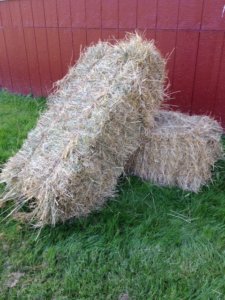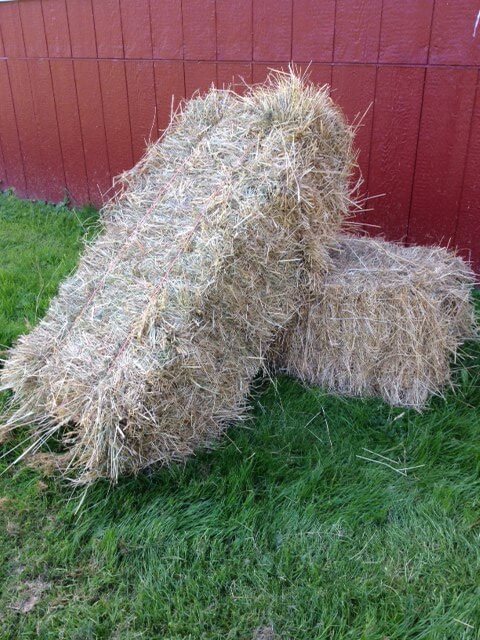What You Need to Know about Certified Weed Free Feed
by Robert Eversole

If you ride in the National Forests or other public property you’ve most likely heard the terms “weed free feed” or “certified weed free forage.” This type of feed is required or requested in many public horse riding and camping areas across the Pacific Northwest and beyond so it’s a good idea to have a basic knowledge about what they are and, more importantly, which feeds fulfill the requirements. No one wants to have an enjoyable camping trip spoiled because of a hefty fine for breaking the rules.
The problem of invasive weed seeds is very real with published reports estimating the economic impact to be as much as $138 billion dollars annually. To combat this threat, agencies across the US are responding aggressively. Although several studies and academic papers have been published that show stock use poses very little probability of spreading noxious weeds, laws have been enacted that we must comply with to avoid being fined, or worse. You can prevent any such worries by researching the requirements of the area you’re planning on riding in and then deciding how to comply with the law.
Forage, or unprocessed hay, and some processed feeds such as cubes and pellets must meet the standards of the North American Weed Management Association (NAWMA) to conform to the rules. Certified noxious weed-seed-free hay bales are distinguished by a bale tag or uniquely colored twine, and represent a hay field that has been inspected by state agriculture officials for noxious weeds. Bales of certified hay can be the size and weight of a normal bale or a “double pressed” form that is half the size of regular bale but contains the same amount of hay by weight. Certified weed free hay cubes and pellets are minimally processed feeds, essentially hay that has been either chopped into a cube or ground and heat-pressure-treated into a cube or pellet form. Bags of certified noxious weed free forage cubes/pellets will be labeled with a certification stating compliance with the North American Weed Free Forage Certification Program.
Compared to a certified weed free hay bale, pellets and cubes create less mess and waste. In addition, the packaging of a processed product makes it easier to pack. Commercially processed feed pellets or steamed, rolled grains are processed by finely grinding the ingredients, heat treating, and then compressing into pellets and do not need to be certified. These complete feeds (usually in large or small pellet form), in which ground hay is balanced with grains for energy, vitamins, and minerals, are designed to replace 100% of the hay or pasture diet. Nutritionally speaking, the processed feeds have a guaranteed nutrient content. Fiber, energy, protein, vitamin, and mineral sources have all been balanced by a nutritionist to provide a complete feed. Therefore, you won’t need to package additional grain or supplement.
It is entirely your preference which weed free option (unprocessed forage, cubed hay, or commercially processed feed) to use during your next trip into a regulated area. Unprocessed feeds are more similar to your horse’s normal feed, but may be more difficult to find. Commercially processed feeds are readily available, but don’t provide the roughage that an equine gut was designed to digest. Many experienced horse campers will take and use all three according to their personal preferences. It is common to offer some hay and supplement with cubed or pelletized feeds to round out the diet.
Regardless of which type of feeds you decide on, make sure that any tags or certificates stay with the feed in case a ranger or land manager asks to verify compliance with the law. Also, if you’re changing your horse’s diet begin gradually, a few days in advance of the trip, so your horse can get used to the new feed. Sudden feed changes can cause colic.
Decide which method of feeding certified weed free product is best for you by weighing the convenience of a packaged product to the fiber length of the hay bale. Whatever choices you make, have fun enjoying the trails from the back of your horse or mule.
As always for more information on this and other trail riding topics visit www.TrailMeister.com.
Published September 2012 Issue

Robert Eversole, ”the trail meister,” owns www.TrailMeister.com, the largest database of horse riding and camping areas in the U.S. with free trail and trailhead information, trail maps, and much more to help horse enthusiasts experience the joys of trail riding. Robert is a registered riding instructor with PATH International, a mounted search and rescue team member, and a U.S. Marine who has served on the board of the Backcountry Horsemen of Washington (BCHW). He is enjoying his new career helping fellow trail riders stay found and safe on the trail. When not on the trail, The Trail Meister resides near Spokane, WA and teaches land navigation to a wide variety of outdoor groups across the nation. For North America’s largest horse trail and camping directory, trail tips, and more, visit www.TrailMeister.com.

